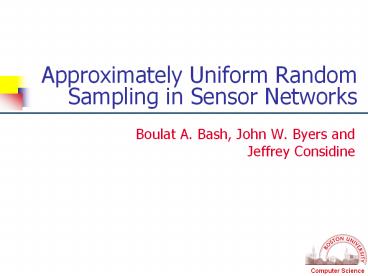Approximately Uniform Random Sampling in Sensor Networks - PowerPoint PPT Presentation
Title:
Approximately Uniform Random Sampling in Sensor Networks
Description:
Approximately Uniform Random Sampling in Sensor Networks Boulat A. Bash, John W. Byers and Jeffrey Considine – PowerPoint PPT presentation
Number of Views:111
Avg rating:3.0/5.0
Title: Approximately Uniform Random Sampling in Sensor Networks
1
Approximately Uniform Random Sampling in Sensor
Networks
- Boulat A. Bash, John W. Byers and Jeffrey
Considine
2
Introduction
- What is this talk about?
- Selecting (sampling) a random node in a sensornet
- Why is sampling hard in sensor networks?
- Unreliable and resource-constrained nodes
- Hostile environments
- High inter-node communication costs
- How do we measure costs?
- Total number of fixed-size messages sent per query
3
Motivation
- Sampling makes data aggregation simpler
- Approximations to AVG, MEDIAN, MODE
- A lot of work on aggregation queries in
sensornets - TAG, Cougar, FM Sketches
- Sampling is crucial to randomized algorithms
- e.g. randomized routing
4
Outline
- Exact uniform random sampling
- Previous work
- Approximately uniform random sampling
- Naïve biased solution
- Our almost-unbiased algorithm
- Experimental validation
- Conclusions and future work
5
Sampling Problem
- Exact uniform random sampling
- Each sensor s is returned from network of n
reachable sensors with probability 1/n - Existing solution (Nath and Gibbons, 2003)
- Each sensor s generates (rs, IDs) where rs is a
random number - Network returns ID of the sensor with minimal rs
- Cost ?(n) transmissions
6
Relaxed Sampling Problem
- (e, d)-sampling
- Each sensor s is returned with probability no
greater than (1e)/n, and at least (1-d)?n
sensors are output with probability at least 1/n
7
Naïve Solution
- Spatial Sampling
- Return the sensor closest to a random (x,y)
- Possible with geographic routing (GPSR 2001)
- Nodes know own coordinates (GPS, virtual coords,
pre-loading) - Fully distributed state limited to neighbors
locations - Cost ?(D) transmissions, D is network diameter
Yes!!!
n10
8
Pitfall in Spatial Sampling
- Bias towards large Voronoi cells
- Definition Set of points closer to sensor s than
any other sensor (Descartes, 1644) - Areas known to vary widely
n10
Voronoi diagram
9
Removing Bias
- Rejection method
- In each cell, mark area of smallest Voronoi cell
- Only accept probes that land in marked regions
- In practice, use Bernoulli trial for acceptance
with Pacc Amin/As (von Neumann, 1951) - Find own cell area As using neighbor locations
(from GPSR) - Need Aavg/Amin probes per sample on average
Ugh
Yes!!!
n10
10
Rejection-based Sampling
- Problem Minimum cell area may be small
- Solution Under-sample some nodes
- Let Athreshold Amin be globally-known cell area
- Route probe to sensor s closest to random (x,y)
- If As lt Athreshold, then sensor s accepts
- Else, sensor accepts with Pracc
Athreshold/As - Athreshold set by user
- For (e, d)-sampling, set to the area of the cell
that is the k-quantile, where - Cost ?(cD) transmissions, where c is the
expected number of probes
11
James Reserve Sensornet
12
James Reserve Sensornet
- 52 sensors
13
Synthetic topology
- 215 sensors randomly placed on a unit square
14
Improving Algorithm
- Put some nodes with small cells to sleep
- No sampling possible from sleeping nodes
- Similar to power-saving schemes (Ye et al. 2002)
- Virtual Coordinates (Rao et al. 2003)
- Hard lower bound on inter-sensor distances
- Pointers
- Large cells donate their unused area to nearby
small cells - When a large cell rejects, it can
probabilistically forward the probe to one of its
small neighbors
15
Conclusions
- New nearly-uniform random sampling algorithm
- Cost proportional to sending a point-to-point
message - Tunable (and generally small) sampling bias
- Future work
- Extend to non-geographic predicates
- Reduce messaging costs for high number of probes
- Move beyond request/reply paradigm
- Apply to DHTs like Chord (King and Saia, 2004)































